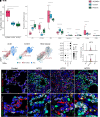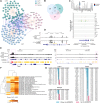Single Cell Multiomics Identifies Cells and Genetic Networks Underlying Alveolar Capillary Dysplasia
- PMID: 37463497
- PMCID: PMC10515568
- DOI: 10.1164/rccm.202210-2015OC
Single Cell Multiomics Identifies Cells and Genetic Networks Underlying Alveolar Capillary Dysplasia
Abstract
Rationale: Alveolar capillary dysplasia with misalignment of pulmonary veins (ACDMPV) is a lethal developmental disorder of lung morphogenesis caused by insufficiency of FOXF1 (forkhead box F1) transcription factor function. The cellular and transcriptional mechanisms by which FOXF1 deficiency disrupts human lung formation are unknown. Objectives: To identify cell types, gene networks, and cell-cell interactions underlying the pathogenesis of ACDMPV. Methods: We used single-nucleus RNA and assay for transposase-accessible chromatin sequencing, immunofluorescence confocal microscopy, and RNA in situ hybridization to identify cell types and molecular networks influenced by FOXF1 in ACDMPV lungs. Measurements and Main Results: Pathogenic single-nucleotide variants and copy-number variant deletions involving the FOXF1 gene locus in all subjects with ACDMPV (n = 6) were accompanied by marked changes in lung structure, including deficient alveolar development and a paucity of pulmonary microvasculature. Single-nucleus RNA and assay for transposase-accessible chromatin sequencing identified alterations in cell number and gene expression in endothelial cells (ECs), pericytes, fibroblasts, and epithelial cells in ACDMPV lungs. Distinct cell-autonomous roles for FOXF1 in capillary ECs and pericytes were identified. Pathogenic variants involving the FOXF1 gene locus disrupt gene expression in EC progenitors, inhibiting the differentiation or survival of capillary 2 ECs and cell-cell interactions necessary for both pulmonary vasculogenesis and alveolar type 1 cell differentiation. Loss of the pulmonary microvasculature was associated with increased VEGFA (vascular endothelial growth factor A) signaling and marked expansion of systemic bronchial ECs expressing COL15A1 (collagen type XV α 1 chain). Conclusions: Distinct FOXF1 gene regulatory networks were identified in subsets of pulmonary endothelial and fibroblast progenitors, providing both cellular and molecular targets for the development of therapies for ACDMPV and other diffuse lung diseases of infancy.
Keywords: FOXF1; alveolar capillary dysplasia; pulmonary microvasculature.
Figures








Comment in
-
When Development of the Alveolar Gas Exchange Unit Fails: Universal Single-Cell Lessons from Rare Monogenic Disorders.Am J Respir Crit Care Med. 2023 Sep 15;208(6):652-654. doi: 10.1164/rccm.202307-1271ED. Am J Respir Crit Care Med. 2023. PMID: 37555730 Free PMC article. No abstract available.
References
-
- Kurland G, Deterding RR, Hagood JS, Young LR, Brody AS, Castile RG, et al. American Thoracic Society Committee on Childhood Interstitial Lung Disease (chILD) and the chILD Research Network An official American Thoracic Society clinical practice guideline: classification, evaluation, and management of childhood interstitial lung disease in infancy. Am J Respir Crit Care Med . 2013;188:376–394. - PMC - PubMed
Publication types
MeSH terms
Substances
Supplementary concepts
Grants and funding
- R01 HL166283/HL/NHLBI NIH HHS/United States
- P30DK117467/DK/NIDDK NIH HHS/United States
- R01 HL164414/HL/NHLBI NIH HHS/United States
- R01 HL149631/HL/NHLBI NIH HHS/United States
- R01 HL152973/HL/NHLBI NIH HHS/United States
- U01 HL148856/HL/NHLBI NIH HHS/United States
- U01 HL148867/HL/NHLBI NIH HHS/United States
- R01HL164414/HL/NHLBI NIH HHS/United States
- R01HL153045/HL/NHLBI NIH HHS/United States
- R01 HL153045/HL/NHLBI NIH HHS/United States
- U01HL134745/HL/NHLBI NIH HHS/United States
- U01HL148856/HL/NHLBI NIH HHS/United States
- P30 DK117467/DK/NIDDK NIH HHS/United States
- U01 HL134745/HL/NHLBI NIH HHS/United States
- U01HL122642/HL/NHLBI NIH HHS/United States
- S10 OD026929/OD/NIH HHS/United States
- U01 HL122642/HL/NHLBI NIH HHS/United States
- R01 HL141174/HL/NHLBI NIH HHS/United States
LinkOut - more resources
Full Text Sources

